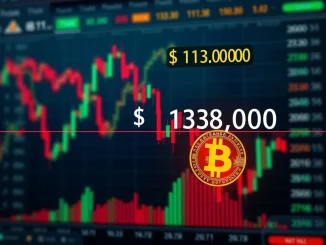
The cryptocurrency market recently experienced a seismic event, with a staggering $727 million in crypto futures positions obliterated within a mere 24 hours. This included a particularly brutal hour that saw $126 million vanish, underscoring the extreme volatility and inherent risks of leveraged trading in the digital asset space. For many, this sudden downturn served as a stark reminder of the delicate balance between immense opportunity and devastating loss in crypto.
Understanding Crypto Liquidations: What Happened?
When we talk about crypto liquidations, we’re referring to the forced closure of a trader’s leveraged position by an exchange due to insufficient margin to cover losses. Think of it like a safety net for exchanges and a painful wake-up call for traders. If the market moves against a highly leveraged position, and the trader doesn’t add more collateral (margin), the exchange automatically closes the position to prevent further losses for both parties.
The recent event saw a massive surge in these forced closures. Here’s a breakdown of what typically fuels such a dramatic liquidation cascade:
Excessive Leverage: Many traders use high leverage (e.g., 50x, 100x) to amplify potential gains. However, this also magnifies losses, making positions incredibly sensitive to even minor price fluctuations.
Sudden Price Drops: A sharp, unexpected downward movement in asset prices triggers margin calls for long positions (bets on rising prices).
Cascading Effect: As positions are liquidated, the forced selling adds further downward pressure on prices, which in turn triggers more liquidations, creating a vicious cycle that accelerates market declines.
The Peril of Leveraged Trading: Why It’s Risky
Leveraged trading allows participants to control a large position with a relatively small amount of capital. While this can amplify profits, it equally amplifies losses, making it a double-edged sword. The recent $727 million wipeout is a prime example of the inherent dangers. Imagine borrowing money to make a large bet; if your bet goes south, you’re not just losing your initial capital, but also the borrowed funds, potentially leading to a much larger debt.
In the crypto world, where volatility is the norm, the margin for error with high leverage is minuscule. A 1% price drop could be enough to liquidate a 100x leveraged long position. This highlights why responsible leverage usage, typically between 2x-5x, is often recommended by seasoned analysts, rather than the ultra-high leverage options some platforms offer.
Bitcoin and Ethereum Bear the Brunt: Key Players in the Selloff
As expected, Bitcoin (BTC) and Ethereum (ETH) accounted for the lion’s share of the liquidations. Given their dominance in trading volume and open interest across futures markets, they are always at the epicenter of such events. When these market leaders experience significant price declines, the ripple effect is felt across the entire ecosystem.
While altcoins like Solana (SOL) also faced considerable liquidations, their impact was proportionally smaller compared to BTC and ETH. This pattern is consistent with historical market downturns, where long positions on the major cryptocurrencies are disproportionately affected as falling prices trigger widespread margin calls.
Navigating a Crypto Market Crash: Strategies for Resilience
A crypto market crash, like the one witnessed, is often driven by a confluence of factors. Beyond excessive leverage and sudden price drops, broader macroeconomic concerns, regulatory uncertainties, and geopolitical developments can amplify sell-offs. While no single trigger was definitively identified for this particular event, the collective fear and uncertainty can create a powerful downward momentum.
For traders and investors, these events serve as a crucial learning experience. The immediate implications are clear: capital erosion and heightened volatility. However, they can also act as a ‘reset’ button for the market, purging excessive leverage and potentially paving the way for a healthier, more sustainable recovery by flushing out over-leveraged positions.
Beyond the Numbers: Impact on Trader Sentiment
The psychological toll of rapid losses cannot be overstated. Sudden liquidation events not only erase capital but also severely erode confidence, particularly among newer participants who may be unfamiliar with the brutal realities of leveraged trading. Post-liquidation periods often see a significant reduction in open interest, reflecting a temporary retreat from speculative positions as traders lick their wounds and reassess their strategies.
Emotional decision-making during periods of high volatility often exacerbates losses. Fear of missing out (FOMO) can lead to over-leveraging on the way up, while panic selling can lock in losses during a downturn. Understanding these psychological biases is as crucial as understanding market mechanics.
Actionable Insights: Mastering Risk Management in Crypto
The recent episode unequivocally reinforces the critical importance of robust risk management. Here are key strategies analysts emphasize for mitigating liquidation risks:
Limit Leverage: Avoid excessively high leverage (e.g., 50x, 100x). Stick to conservative levels, typically 2x-5x, to provide more buffer against price swings.
Utilize Stop-Loss Orders: These automatically close your position if the price reaches a predetermined level, limiting potential losses and preventing liquidation.
Maintain Sufficient Collateral: Ensure you have adequate margin in your account to withstand market fluctuations. Don’t trade with the bare minimum.
Position Sizing: Never allocate an uncomfortably large portion of your portfolio to a single highly leveraged trade. Diversify and size positions appropriately.
Continuous Education: The crypto market is dynamic. Stay informed about market dynamics, regulatory changes, and new trading tools. Emotional control, discipline, and a clear trading plan are paramount.
Looking Ahead: A Market Reset or Continued Volatility?
While futures trading offers vital opportunities for hedging and price discovery in the crypto market, the recent liquidations highlight the sector’s persistent challenges. High volatility, complex mechanics, and the psychological toll of rapid losses remain significant hurdles for both retail and institutional investors.
This event serves as a stark reminder of the delicate balance between immense opportunity and profound risk in the crypto space. Whether this marks a temporary market reset, purging the excesses and paving the way for healthier growth, or simply another volatile chapter, one thing is clear: prudence and education are the most powerful tools in a trader’s arsenal.
Frequently Asked Questions (FAQs)
Q1: What exactly are crypto liquidations?
Crypto liquidations occur when a trader’s leveraged position is automatically closed by an exchange because the market moved against their bet, and they no longer have sufficient margin (collateral) to cover potential losses. It’s a mechanism to prevent traders from incurring more debt than their collateral and to protect the exchange.
Q2: Why did $727 million in crypto futures positions get liquidated?
The massive liquidation was primarily driven by a combination of factors: sudden, sharp price declines in major cryptocurrencies like Bitcoin and Ethereum, coupled with excessive leverage used by many traders. When prices fell, highly leveraged positions quickly hit their liquidation thresholds, triggering a cascading effect of forced selling.
Q3: How does leveraged trading contribute to such large liquidations?
Leveraged trading allows traders to open positions larger than their actual capital. While this can amplify profits, it also significantly magnifies losses. With high leverage (e.g., 50x or 100x), even small price movements can wipe out a trader’s margin, leading to liquidation and contributing to broader market instability through forced selling.
Q4: Which cryptocurrencies were most affected by these liquidations?
Bitcoin (BTC) and Ethereum (ETH) bore the brunt of the liquidations. Due to their large trading volumes and open interest in futures markets, they consistently account for the majority of liquidation activity during periods of high volatility. Altcoins like Solana (SOL) also experienced liquidations, though to a lesser extent.
Q5: What can traders do to avoid being liquidated?
To mitigate liquidation risks, traders should implement strong risk management strategies. This includes limiting leverage to conservative levels (e.g., 2x-5x), always using stop-loss orders to cap potential losses, maintaining sufficient collateral in their accounts, and practicing proper position sizing. Continuous education on market dynamics and avoiding emotional trading are also crucial.
Q6: Do liquidations signal a broader crypto market crash?
While large-scale liquidations often coincide with significant price drops and can feel like a market crash, they also serve as a ‘reset’ mechanism by flushing out excessive leverage. While painful, this can sometimes pave the way for a healthier market recovery. However, they do highlight periods of extreme volatility and heightened risk.



